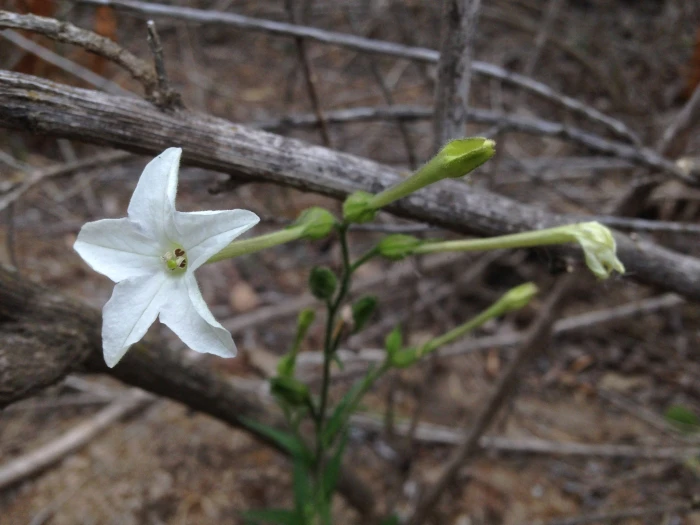Indian Tobacco
(Nicotiana quadrivalvis)
Indian Tobacco (Nicotiana quadrivalvis)
/
/

Adam J. Searcy
CC BY 4.0
Image By:
Adam J. Searcy
Recorded By:
Copyright:
CC BY 4.0
Copyright Notice:
Photo by: Adam J. Searcy | License Type: CC BY 4.0 | License URL: http://creativecommons.org/licenses/by/4.0/ | Rights Holder: Adam J. Searcy | Publisher: iNaturalist | Date Created: 2015-06-04T06:57:15-07:00 |






















Estimated Native Range
Climate Requirements for Lakeville, Minnesota
| This Plant | Your Site | Plant Suitability for Your Location | ||
|---|---|---|---|---|
| • Precipitation | 3" - 62" | 31" | Your precipitation may be too high for this plant. | Too high |
| • High Temp. | 67°F - 112°F | 83°F | Your summer temperatures are normal for this plant. | Excellent |
| • Low Temp. | 8°F - 49°F | 2°F | Your winter temperatures may be too cold for this plant | Too cold |
This plant may not grow well at your location - your precipitation is too high.
Summary
Nicotiana quadrivalvis, commonly known as Indian tobacco or Columbian tobacco, is an annual herb that is native to riparian zones, moist places in grasslands, and open woodlands in the western United States, particularly California. It can grow up to 7 feet in height, with lower leaf blades that are up to 6 inches long. The plant features an inflorescence of white, greenish, or purple-tinged tubular flowers that bloom from late spring to early fall. The flowers are modest in size but can be quite numerous, creating a delicate display.
Indian tobacco is valued for its historical and cultural significance rather than its ornamental qualities. It is not commonly cultivated in gardens but may be of interest to those looking to create a native plant garden or for educational purposes. In cultivation, it prefers moist, well-drained soils and can tolerate a range of light conditions from full sun to partial shade. While it is not known for being particularly problematic, it may be susceptible to common pests and diseases that affect other Nicotiana species. It is also important to note that all parts of the plant are toxic if ingested.CC BY-SA 4.0
Indian tobacco is valued for its historical and cultural significance rather than its ornamental qualities. It is not commonly cultivated in gardens but may be of interest to those looking to create a native plant garden or for educational purposes. In cultivation, it prefers moist, well-drained soils and can tolerate a range of light conditions from full sun to partial shade. While it is not known for being particularly problematic, it may be susceptible to common pests and diseases that affect other Nicotiana species. It is also important to note that all parts of the plant are toxic if ingested.CC BY-SA 4.0
Plant Description
- Plant Type: Herb
- Height: 2-5 feet
- Width: 1-3 feet
- Growth Rate: Rapid
- Flower Color: Green, Purple, White
- Flowering Season: Spring, Summer, Fall
- Leaf Retention:
Growth Requirements
- Sun: Full Sun
- Water: Medium
- Drainage: Medium, Fast
Common Uses
Bee Garden, Butterfly Garden, Low Maintenance
Natural Habitat
Native to riparian zones, moist places in grasslands, and open woodlands in the western United States, particularly California
Other Names
Common Names: Wild Tobacco
Scientific Names: Nicotiana quadrivalvis, Amphipleis quadrivalvis, Dictyocalyx multivalvis, Dictyocalyx multivalvis, Dictyocalyx quadrivalvis, Dictyocalyx quadrivalvis, Nicotiana bigelovii subsp. multivalvis, Nicotiana bigelovii subsp. quadrivalvis, Nicotiana bigelovii var. multivalvis
GBIF Accepted Name: Nicotiana quadrivalvis